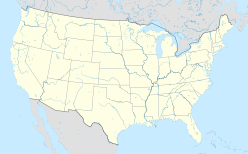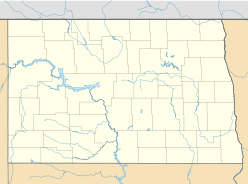Red Wing crater facts for kids
| Red Wing Creek structure | |
| Impact crater/structure | |
|---|---|
| Confidence | Confirmed |
| Diameter | 9 km (5.6 mi) |
| Age | 200 ± 25 Ma Late Triassic or Early Jurassic |
| Exposed | No |
| Drilled | Yes |
| Location | |
| Location | Watford City |
| Coordinates | 47°36′N 103°33′W / 47.600°N 103.550°W |
| Country | |
| State | North Dakota |
| Province | McKenzie County |
The Red Wing or Red Wing Creek structure is a huge hole in the ground, called an impact crater, made by a meteor hitting the Earth. It's located in McKenzie County, North Dakota, which is in the United States. This crater is about 24 km (15 mi) southwest of Watford City, North Dakota.
You can't see the Red Wing crater from the surface because it's buried deep underground. Scientists found it using special sound wave technology called seismic studies. This amazing discovery also led to finding oil in the area back in 1972. The Red Wing crater is about 9 km (5.6 mi) wide. It is buried very deep, around 2,000 m (6,600 ft) below the surface. Scientists believe this crater is very old, about 200 million years old. This means it formed during a time period known as the Triassic or Jurassic period.
Contents
How Was Red Wing Crater Found?
The Red Wing Creek structure shows up very clearly when scientists use seismic studies. These studies use sound waves to create pictures of what's underground. They showed that older rock layers, like those from the Ordovician period, were covered by messed-up rocks from the Devonian and Mississippian periods.
The big hole made by the impact was later filled in by thick layers of rock from the Jurassic period. This suggests that the meteor impact happened during the Triassic period, before the Jurassic rocks formed.
Discovering Oil
In the 1960s, a company called Shell Oil Company drilled wells in the Red Wing Creek area. They were looking for oil but didn't find any at first. However, their drilling showed that some rock layers, like those from the Mississippian and Pennsylvanian periods, were much thicker than expected.
Then, in 1972, another company, True Oil Company, drilled a well and found oil! This oil discovery was special because the oil layer was incredibly thick, about 870 m (2,850 ft). Normally, oil layers are only about 30 m (98 ft) thick. The reason for this super thick oil layer was that the rocks had been tilted on their sides by the impact.
Proving the Impact
Finding oil in the area made geologists (scientists who study rocks) and geophysicists (scientists who study the Earth's physical processes) very interested in the Red Wing Creek area. They started studying it closely. In 1996, a scientist named Christian Koeberl and his team made a big discovery. They found something called planar deformation features (PDFs) in rock samples from oil wells at the center of the structure.
PDFs are tiny, special marks inside rock crystals. They only form when rocks are hit with extreme force, like during a giant meteor impact. Finding these PDFs was clear proof that the Red Wing Creek structure was indeed formed by a meteor impact.
Could It Be Part of a Bigger Event?
Some scientists, like Geophysicist David Rowley from the University of Chicago, have an interesting idea. They suggest that the Red Wing crater might be one of several craters that formed at the same time. This would mean a huge space rock broke into pieces and hit Earth in multiple places all at once!
Rowley, working with other scientists, noticed that the Red Wing crater seemed to line up with other craters around the world. These include the Manicouagan crater in Canada, the Rochechouart crater in France, the Saint Martin crater in Canada, and the Obolon' crater in Ukraine.
These craters were already known and studied individually. But their ancient alignment, meaning they lined up from a very long time ago, had never been shown before. Rowley believes the chance of these craters lining up like this by accident is almost impossible. This makes the idea of a "multiple impact event" very exciting for scientists!



